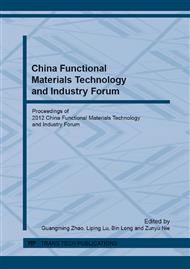p.190
p.196
p.202
p.208
p.214
p.220
p.226
p.230
p.235
Preparation and Property of Radiant Thermal Insulation Coating Based on Tourmaline and Hollow Glass Bead
Abstract:
The radiant thermal insulation coating is prepared by tourmaline and hollow glass bead as main functional additives. The thermal insulation property is evaluated by thermal insulation effect and far infrared emissivity. The results show that the optimum contents of functional additives are as follows: hollow glass bead 4%, tourmaline particle 8%. The integral mean of far infrared emissivity and thermal insulation effect of radiant thermal insulation coating are improved by 3.812% and 6.66°C, respectively. The mechanism of thermal insulation is that the structure of hollow glass bead generates scattering and multiple reflections of solar radiation, and then tourmaline particle and the oxides of hollow glass bead radiate the absorbed heat from coating to atmosphere.
Info:
Periodical:
Pages:
214-219
Citation:
Online since:
May 2013
Authors:
Price:
Сopyright:
© 2013 Trans Tech Publications Ltd. All Rights Reserved
Share:
Citation:


